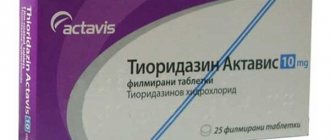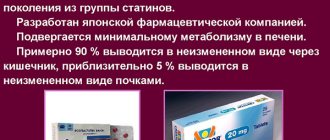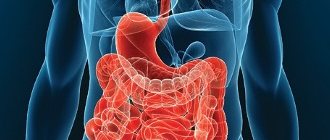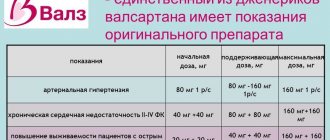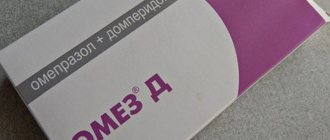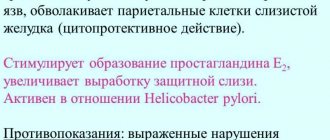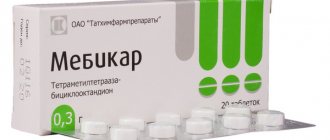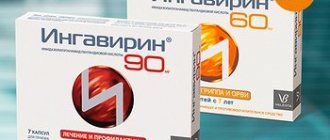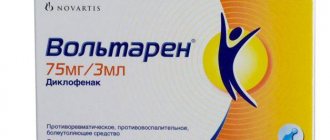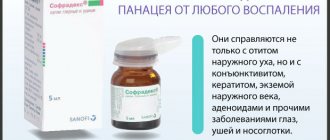There are restrictions during pregnancy
Has restrictions when breastfeeding
Has restrictions for children
Has restrictions for older people
Has limitations for liver problems
Has limitations for kidney problems
Risperidone belongs to the pharmacological group of monoamine antagonists and contains the active component of the same name. If you are allergic to the composition of Risperidone, your doctor will prescribe analogues based on a different active ingredient, but having a similar therapeutic effect on the body.
The drug suppresses the symptoms of schizophrenia, to a much lesser extent compared to other antipsychotics, suppressing motor activity and without causing catalepsy. The medication eliminates hallucinations, aggressiveness, delusional syndrome and various phobias.
Packaging of the drug Risperidone
Risperidone is prescribed for:
- chronic or acute phase of schizophrenia;
- psychosis;
- affective pathologies of various etiologies;
- manic syndrome (as part of combination treatment);
- delirium;
- aggressiveness and overexcitement.
Prescribed to adolescents over 15 years of age with impaired intellectual development and with increased emotionality, impulsivity and aggression.
Risperidone is not prescribed if you are allergic to the components in the composition or during lactation. Pregnant women are prescribed the medicine when there is a vital sign and under the supervision of a doctor.
You need to take Risperidone 1-2 times a day. Therapy should be started with a dosage of 2 mg, and after a day doubled. The maximum dosage per day is 10 mg. In rare cases, with severe pathology, the dosage is 16 mg. In adolescents and children weighing more than 50 kg, 1 mg per day is prescribed.
Side effects:
- dizziness, agitation, muscle weakness and tremors of the limbs;
- hyperthermia and disturbances in thermoregulation;
- dyspepsia and increased transaminase activity;
- arrhythmia, decreased blood pressure;
- disturbances in hemostasis;
- skin allergies – urticaria, itching, hyperthermia;
- Erectile dysfunction and enuresis in men;
- myalgia, arthralgia.
Release form and composition
Risperidone is available in the following dosage forms:
- solution for oral administration: a clear, colorless liquid with a characteristic faint odor (30 ml or 100 ml in orange glass bottles or polymer bottles, equipped with an adapter and sealed with a screw cap with first opening control, in a cardboard box 1 bottle per complete with a dosing syringe and instructions for the drug);
- film-coated tablets: biconvex, round, shell and core on a break from white to almost white or biconvex, capsule-shaped, with an engraving on one side - “A”, on the other side there is a line mark, the color of the tablet and an engraving on the other side depend on the dosage (0.5 mg – green shell, engraving – “50”; 1 mg – white shell, engraving – “51”; 2 mg – light orange shell, engraving – “52”; 3 mg – yellow shell, engraving – “53”; 4 mg – green shell, engraving – “54”; 6 mg – white shell, engraving – “55”) (5, 10, 15, 20 or 30 pcs. per blister packs, in a cardboard pack 4 blister packs with 5 tablets, 2, 3, 6 or 9 blister packs with 10 tablets, 2, 4 or 6 blister packs with 15 tablets, 1 or 3 blister packs with 20 tablets, 1, 2 or 3 contour packages with 30 tablets; 20, 30, 60 or 90 pieces in polymer jars, 1 jar in a cardboard pack. Each package also includes instructions for the use of Risperidone).
Composition per 1 ml of oral solution:
- active ingredient: risperidone – 1 mg;
- auxiliary components: sodium hydroxide (up to pH level 3±0.2), sodium benzoate, tartaric acid, water.
Composition per 1 film-coated tablet:
- active ingredient: risperidone – 0.25; 0.5; 1; 2; 3; 4 or 6 mg;
- auxiliary components: corn starch, magnesium stearate, microcrystalline cellulose, lactose monohydrate, colloidal silicon dioxide;
- film coating: common components for all dosages - titanium dioxide, hypromellose, macrogol; additional components – indigo carmine and quinoline yellow dye (for tablets 0.5 mg and 4 mg); dyes iron oxide yellow, iron oxide black and iron oxide red (for tablets 2 mg); quinoline yellow dye (for 3 mg tablets).
Due to the large number of manufacturers of Risperidone, the appearance of the tablets, their shape and composition of auxiliary ingredients, as well as packaging are possible.
Pharmacological properties
Pharmacodynamics
Risperidone has sedative, antipsychotic, hypothermic and antiemetic effects. It is a selective antagonist of dopamine D2 and serotonin 5-HT2 receptors. In addition, it can bind to α1-adrenergic receptors, α2-adrenergic receptors and H1-histamine receptors (the latter two to a slightly lesser extent). Does not have affinity (affinity) for cholinergic receptors.
The mechanism of the antipsychotic action of the drug is due to the blockade of dopamine D2 receptors in the mesocortical and mesolimbic systems. The sedative effect occurs as a result of blockade of α-adrenergic receptors of the reticular formation; hypothermic properties appear due to blockade of dopamine receptors in the hypothalamus; antiemetic activity is associated with blockade of dopamine D2 receptors of the vomiting center and trigger zone.
Risperidone reduces automaticity and productive symptoms (hallucinations, delusions and aggressiveness). Unlike classical antipsychotics, the drug suppresses motor activity to a lesser extent and induces waxy flexibility (catalepsy).
Simultaneous blockade of D2-dopamine and 5-HT2 serotonin receptors in the CNS (central nervous system) expands the range of therapeutic effects on the affective and negative symptoms of schizophrenia and reduces the likelihood of extrapyramidal adverse reactions.
Under the influence of risperidone, a dose-dependent increase in the level of prolactin in the blood is possible.
Pharmacokinetics
Risperidone is quickly and completely absorbed from the gastrointestinal tract (gastrointestinal tract), while food consumption does not affect the speed and completeness of absorption. The absolute bioavailability of the drug in solution form is about 70%, in tablets – 94%. After 1–2 hours, the maximum concentration of the active substance is detected in the blood plasma. Plasma levels of risperidone depend on the dose taken. In most patients, the equilibrium concentration of the drug is established within 24 hours, and 9-hydroxyrisperidone (the main metabolite with pharmacological activity) - after 4-5 days.
Risperidone is well and fairly quickly distributed in organs and tissues. The volume of distribution is 1–2 l/kg body weight. The binding of the active substance to plasma proteins is 88%, its active metabolite is about 77% (albumin and α1-glycoprotein are mainly involved in binding).
Metabolism occurs in the liver, with the participation of the CYP2D6 isoenzyme. Risperidone is biotransformed by hydroxylation (9-hydroxyrisperidone is formed) and N-dealkylation (the significance of this biotransformation pathway is minimal). Risperidone and its main active metabolite form AAPF (active antipsychotic fraction). The pharmacokinetics of the drug and the therapeutic efficacy of metabolites are almost the same among different phenotypes (despite the fact that hydroxylation of the active substance is subject to genetic diversity).
With active metabolism, the half-life of risperidone is about 3 hours, and with slow metabolism - approximately 20 hours (9-hydroxyrisperidone - 21 and 30 hours, respectively). The half-life of AAPF, regardless of phenotype, is 24 hours.
After a week of taking risperidone, about 70% of the dose taken is excreted by the kidneys, another 14% through the intestines. Approximately 35–45% of the substance excreted by the kidneys consists of the unchanged fraction and the main active metabolite.
In renal failure, the clearance of ACE is reduced by 60%. In case of liver failure, the average free fraction of the drug increases by approximately 35%, but this does not affect the plasma concentration of risperidone.
In elderly patients, a single dose of the drug led to a decrease in plasma ACE clearance by 30% and an increase in half-life by 38%.
In children, the pharmacokinetic parameters of the drug do not differ from those in adults.
The effects of smoking, gender, and race on the pharmacokinetics of risperidone are minor and have no clinical significance.
Indications for use
- schizophrenia and other psychotic conditions with severe negative and/or productive symptoms (including acute and chronic schizophrenia, as well as acute psychosis that occurred for the first time) in adults and adolescents 13–17 years old;
- moderate and severe manic episodes associated with bipolar disorder in children and adolescents over 10 years of age and adults (as an adjuvant);
- behavioral disorders in patients with dementia;
- short-term (for up to 6 weeks) therapy of persistent aggression in patients with moderate and severe dementia, which arose as a result of Alzheimer's disease and is not amenable to non-drug methods of correction, as well as in cases of high risk of harm by the patient to himself and/or others;
- short-term (for up to 6 weeks) symptomatic treatment of persistent aggression in children over 5 years of age and adolescents with diagnosed mental retardation, in which, due to severe aggression and other types of destructive behavior, treatment with medications is necessary (as an auxiliary therapy);
- affective disorders in other mental illnesses.
Contraindications
Absolute:
- deficiency of the lactase enzyme, hereditary galactose intolerance, impaired galactose/glucose malabsorption (for Risperidone tablets, since they contain lactose);
- breastfeeding period;
- children under 5 years of age (with destructive behavior);
- children under 10 years of age (during the treatment of manic episodes associated with bipolar disorder);
- children and adolescents up to 13 years of age (in the case of treatment of schizophrenia);
- children and adolescents up to 18 years of age (other indications);
- hypersensitivity to the main or auxiliary ingredients of the drug.
Relative (Risperidone is used with caution):
- severe renal and/or liver failure;
- diseases of the cardiovascular system (recent myocardial infarction, chronic heart failure, conduction disorders, including AV block);
- risk factors for tachycardia of the “pirouette” type (electrolyte imbalance, bradycardia, concomitant use with drugs that prolong the QT interval);
- predisposition to the occurrence of thromboembolism of venous vessels;
- circulatory disorders in the brain;
- state of hypovolemia and dehydration;
- hyperglycemia;
- prolactin-dependent tumors (for example, breast cancer) and hyperprolactinemia not associated with taking appropriate drugs;
- epilepsy and seizures (including a history of these diseases);
- DLB (dementia with Lewy bodies);
- Parkinson's disease;
- acute drug intoxication, intestinal obstruction, brain tumor, acute liver failure and encephalopathy (since the symptoms of these diseases and conditions may be masked due to the antiemetic effect of risperidone);
- simultaneous use with furosemide and centrally acting drugs;
- drug dependence or abuse of certain medications;
- old age (for patients with cerebrovascular dementia);
- pregnancy period.
Risperidone: instructions for use (dosage and method)
Both the solution and Risperidone tablets are taken orally, regardless of the time of meal.
Schizophrenia
For adult patients, the drug is prescribed at an initial dose of 2 mg per day (in one or two doses). On the second day, it is necessary to increase the daily dose to 4 mg. In the following days, Risperidone is taken at a dose of 4 mg per day or adjusted taking into account the individual characteristics of the patient. The optimal daily dose is 4 to 6 mg. Sometimes a slower selection of the initial and maintenance dose is justified. Taking a daily dose of Risperidone of 10 mg or higher does not increase the therapeutic effect, but only increases the risk of extrapyramidal disorders. The safety and effectiveness of daily doses greater than 16 mg have not been studied and are not recommended.
For elderly patients, the initial dose should not exceed 0.5 mg twice daily. In the future, it can be increased in increments of 0.5 mg to 1-2 mg twice a day.
For adolescents over 13 years of age, risperidone is prescribed at an initial dose of 0.5 mg once a day (morning or evening). No earlier than 24 hours later, you can increase the dose by 0.5–1 mg, and if well tolerated, up to 3 mg. Increasing the daily dose to 6 mg did not lead to increased effectiveness, but side effects developed more often. There are no data on the safety of daily doses above 6 mg. If a patient experiences persistent drowsiness during treatment with risperidone, it is recommended to divide the daily dose in half and take it in two doses. There is no information on the use of this antipsychotic drug for the treatment of schizophrenia in patients under 13 years of age.
Manic episodes associated with bipolar disorder
For adults, the initial dose is 2 mg per day once. After 24 hours, it is possible to increase the daily dose by 1 mg. As a rule, the optimal dose is from 1 to 6 mg per day. The use of daily doses of the drug exceeding 6 mg has not been studied. Throughout the entire period of therapy, the advisability of further treatment should be periodically assessed.
For elderly patients, risperidone is prescribed at an initial dose of 0.5 mg twice daily. If necessary, increase the dose by 0.5 mg to 1–2 mg twice daily.
In children and adolescents over 10 years of age, treatment begins with a dose of 0.5 mg per day once (morning or evening). After 24 hours, you can increase the dose by 0.5–1 mg to 1–2.5 mg per day (provided that risperidone is well tolerated). For most patients, a dose of 0.5 mg to 6 mg per day is optimal. It should be borne in mind that doses exceeding 2.5 mg per day do not provide additional effectiveness, but only cause a greater number of adverse reactions. There are no data on the use of doses greater than 6 mg per day. There is no information on the use of antipsychotics for the treatment of bipolar disorders in children under 10 years of age.
If the patient experiences persistent drowsiness, it is recommended to take half the daily dose of Risperidone twice daily.
Aggression in patients with dementia due to Alzheimer's disease
The initial dose is 0.25 mg twice a day (in the morning and evening). After 24 hours, you can increase the dose by 0.25 mg twice a day. The optimal dose is 0.5 mg twice a day (with rare exceptions when taking Risperidone 1 mg twice a day is indicated). In patients with persistent aggression, the duration of therapy should not exceed 6 weeks. The patient's condition should be regularly assessed and the issue of suspending or continuing treatment should be decided.
Aggression in children and adolescents over 5 years of age with mental retardation
For patients weighing 50 kg or more, risperidone is prescribed at an initial dose of 0.5 mg per day once. Then this dose can be increased by 0.5 mg, but not earlier than a day later. The optimal daily dose is 1 mg. Variations are possible: some patients need 0.5 mg per day, others require up to 1.5 mg.
It is recommended that children and adolescents weighing up to 50 kg be given the drug at an initial dose of 0.25 mg once a day. After 24 hours, you can increase the dose to 0.5 mg, which is considered optimal for most patients (sometimes it is possible to increase the daily dose to 0.75 mg).
Long-term therapy in childhood and adolescence should be carried out under the constant supervision of a specialist. Risperidone has not been studied in children under 5 years of age.
Behavioral disorders in patients with dementia
Treatment should begin with a dose of 0.25 mg twice a day. After 24 hours, you can increase it to 0.5 mg twice a day. This dose is optimal for most patients. In some cases, it is advisable to take Risperidone 1 mg twice a day. When the optimal dosage is finally determined, a single dose of the entire daily dose is possible.
In patients with kidney and/or liver diseases, regardless of indications, it is necessary to reduce the initial and maintenance doses by 2 times. Dose titration should be done more slowly.
Discontinuation of treatment with Risperidone is carried out gradually, as signs of withdrawal syndrome may occur. Acute symptoms of which include: vomiting, nausea, increased sweating, insomnia; Dyskinesia (involuntary movements) and relapse of psychotic symptoms may occur.
When switching to treatment with the drug from therapy with other antipsychotics at the beginning of the course of taking Risperidone, the previous drug is discontinued gradually (if this step is clinically justified). The patient is transferred from injectable depot forms of antipsychotic drugs immediately, that is, instead of the next planned injection, risperidone therapy is started.
Similar therapeutic agents
Medicines similar to Risperidone in terms of therapeutic action are medicines that have other components in their composition, but have the same therapeutic direction and effect as Risperidone.
Abizol
Abizol is an antipsychotic, which is produced in tablets based on aripiprazole. Abizol is prescribed for the treatment of the following pathologies:
- acute attacks of schizophrenia;
- symptoms of acute attacks of bipolar manic disorder type 1.
It is prohibited to use Abizol in the treatment of pediatric patients, those with sensitivity to the components, or women during the periods of bearing and feeding a child. Prescribed with restrictions for:
- cerebrovascular pathologies;
- IHD and cardiac impulse conduction disorders;
- convulsions;
- hyperthermia;
- hypotension;
- overweight and a history of diabetes.
Abizol is administered orally, without being tied to food intake. Standard dosages for the treatment of schizophrenia are 10-15 mg once a day, the treatment of manic disorders is 15-30 mg once a day.
Negative effects:
- disorders in the digestive organs;
- urticaria, Quincke's edema, skin itching;
- rhabdomyolysis, myasthenia gravis, muscle spasms, arthrosis;
- cardiac arrhythmia and myocardial ischemia;
- thrombosis, hypertension;
- nervous overexcitation, tremor, insomnia;
- shortness of breath, pulmonary edema.
Abilify
Abilify is an antipsychotic drug with the active ingredient aripiprazole. Abilify is produced in tablets that are used in the treatment of the following mental disorders:
- attacks of schizophrenia in the acute phase;
- manic bipolar disorder type 1.
Abilify should not be prescribed in pediatric practice, in case of allergy to the medicinal composition of the drug and lactation. Prescribe with caution when:
- cerebrovascular and cardiac pathologies;
- convulsive seizures;
- hypotension and hypovolemia;
- high risk of developing hyperthermic syndrome;
- overweight;
- the patient's history of diabetes;
- pregnancy (prescribed in rare cases).
Standard dosages for Abilify medication:
- therapy for schizophrenia – 10-15 mg per day. After acute symptoms are relieved, maintenance therapy continues with a dosage of 15 mg;
- manic disorders begin to be treated with a dosage of 15-30 mg. After the removal of severe symptoms, treatment continues with 15-30 mg once or twice a day.
Negative manifestations:
- disorders in the digestive tract;
- urticaria, bronchospasms, Quincke's edema;
- skin hyperemia and skin itching;
- muscle spasms, arthralgia, myopathy, arthrosis;
- myocardial ischemia and disturbances in the conduction of cardiac impulses;
- thrombocytopenia and anemia;
- tachycardia, arrhythmia;
- thrombosis, thrombophlebitis and hypertension;
- nervous overexcitation, dizziness, tremor, drowsiness or insomnia;
- shortness of breath, respiratory depression, pulmonary edema;
- disturbances in urination and erectile function.
Invega
Invega is an antipsychotic drug that contains a racemic mixture of paliperidone of different polarities. The mechanism of action of paliperidone is not similar to the principle of action of antipsychotics. Paliperidone reduces the symptoms of schizophrenia - it reduces catalepsy, as well as motor skills less than other antipsychotics.
The drug is prescribed for the treatment of patients with schizophrenia or schizoaffective disorders and manic symptoms. Inveg was not observed to be active in depressive symptoms.
The medication is not prescribed for:
- allergies to the composition of the drug;
- lactation;
- pregnancy in the 1st and 3rd trimesters, as well as children under 12 years of age.
Can be used with caution when:
- cardiac diseases;
- diabetes;
- predisposition to seizures;
- dysphagia, as well as esophageal stenosis;
- impaired intestinal motility;
- renal and liver failure;
- parkinsonism.
Invega has a prolonged effect, so the tablets must be swallowed whole without breaking the protective coating. The dosage of the medicine and the dosage regimen are determined by the doctor personally for each patient in accordance with the pathology and the degree of its progression:
- schizophrenia – once a day 6 mg. Therapeutic dose of treatment is 3-6 mg;
- patients with kidney/liver pathologies - the dosage is reduced by half.
Side effects:
- digestive disorders, epigastric and abdominal pain;
- hives, rashes and itching;
- skin hyperemia;
- bronchospasms and respiratory depression;
- muscle spasms, myopathy, arthralgia;
- heart attack;
- thrombocytopenia, leukopenia and anemia;
- tachycardia, angina pectoris, ischemic heart disease, arrhythmia;
- hypertension;
- drowsiness, dizziness, or insomnia;
- dyspnea;
- erectile dysfunction.
Amdoal
Amdoal is an atypical antipsychotic with the main component being aripiprazole. The medication is prepared in tablet form and is prescribed for:
- attacks in the acute phase of schizophrenia;
- bipolar disorder type 1 with manic symptoms;
- and also after suffering a mixed bipolar attack.
Amdoal is not prescribed to children under adulthood, patients with intolerance to the drug composition, as well as lactating and pregnant women.
Prescribed with caution for:
- obesity and diabetes;
- diabetes in close blood relatives;
- cerebrovascular pathologies;
- cardiac diseases and after a heart attack;
- convulsive attacks;
- dehydration, overheating and hyperthermic syndrome;
- risk of developing aspiration pneumonia.
The tablets must be taken orally, regardless of food. The doctor calculates the dosage individually, but there are standard doses for the treatment of mental illness:
- treatment of attacks of schizophrenia – 10-15 mg once a day;
- manic bipolar symptoms – 15-30 mg once a day.
For patients with kidney and liver pathologies, doses are reduced by half.
Side effects:
- bleeding gums;
- pancreatitis, gastroenteritis, hepatitis;
- gastritis, gingivitis, flatulence;
- oral candidiasis and dyspepsia;
- allergies to the epidermis and bronchospasms;
- cerebral ischemia and cerebral hemorrhage;
- thrombophlebitis and thrombosis;
- tachycardia, fibrillation, extrasystole and arrhythmia.
Xeplion - an analogue in a different dosage form
Xeplion is prepared in a solution for intramuscular injection into the body. The main ingredient of the suspension is paliperidone. Xeplion is an antipsychotic that is used in the treatment of schizophrenia, as well as as part of preventive measures for relapses of schizophrenia.
It is contraindicated to use Xeplion if the patient’s body is hypersensitive to the composition of the drug, as well as in pediatrics and lactation. During pregnancy, the medication is prescribed only if absolutely necessary and under the supervision of a doctor.
Prescribe with caution for the following concomitant pathologies in the patient:
- hypotension and heart disease;
- convulsive syndrome;
- hyperthermic syndrome;
- prolongation of the QT interval of congenital or acquired etiology;
- arrhythmias;
- parkinsonism and senile dementia.
If the patient has not taken treatment with Xeplion, then he is prescribed oral medications with risperidone or paliperidone for 5-7 days.
Therapy begins with a dosage of 150 mg. Each subsequent month of therapy, injections are given with a dosage of the drug - 75 mg. If necessary, you can adjust the dose and use a therapeutic dosage of 100-150 mg.
When starting therapy, Xeplion injections should be given every month, on the same day of the month. If it is not possible to give an injection on the required date, then you can perform an injection with a deviation of 2-7 days earlier or later than the appointed date.
It is necessary not to skip the frequency of monthly administrations, because if you miss 1 to 6 months, you will have to start the therapeutic course again.
Xeplion is administered only deep intramuscularly. The introduction is carried out very slowly. The medicine must be injected alternately into the right or left buttocks.
See also:
TOP 11 analogues of Tofizopam - substitutes for therapeutic effect
Side effects
- digestive system (gastrointestinal tract, liver and biliary tract): often - dyspeptic disorders, dry oral mucosa, nausea, vomiting, toothache, increased salivation, abdominal pain, constipation or diarrhea, stomach discomfort; infrequently - gastritis, difficulty swallowing, gastroenteritis, severe constipation (fecaloma), flatulence, fecal incontinence; rarely - swelling of the tongue and lips, cheilosis (inflammatory damage to the border and mucous membrane of the lips), jaundice, pancreatitis, intestinal obstruction;
- metabolism and nutrition: often - weight gain, decreased or increased appetite; uncommon – hyperglycemia, diabetes mellitus, weight loss, unquenchable thirst, anorexia; rarely - overhydration, hypoglycemia, increased insulin levels in the blood; very rarely - ketoacidosis;
- cardiovascular system: often - increased blood pressure, increased heart rate; infrequently - flushing of the face, atrial fibrillation, bradycardia, decreased blood pressure, orthostatic hypotension, cardiac conduction disturbances, AV block and His bundle block, palpitations; rarely - sinus arrhythmia or bradycardia, deep vein thrombosis, pulmonary embolism;
- respiratory system: often – nosebleeds, nasal congestion, shortness of breath, pain in the pharynx and larynx, cough; infrequently - moist rales, respiratory distress, changes in the qualitative characteristics of the voice, wheezing, airway obstruction, pulmonary congestion, aspiration pneumonia; rarely – intense breathing, sleep apnea;
- nervous system and psyche: very often - headache, insomnia or drowsiness, suppression of reflexes and pain sensitivity, parkinsonism; often - agitation, anxiety, dizziness, restlessness, dystonia, sleep disturbances, pathological need for movement, lethargy, tremor, involuntary muscle movements; infrequently - lethargy, loss of consciousness and fainting, positional vertigo, nervousness, lack of response to stimuli, mania, nightmares, impaired attention, balance, coordination, speech and movement, decreased libido, dysarthria, taste perversion or taste disorder, confusion, excessive daytime drowsiness, cerebral ischemia, transient ischemic attacks, stroke, psychomotor hyperactivity, tardive dyskinesia, paresthesia, convulsions; rarely - diabetic coma, head tremor, affective flattening, complete or partial absence of orgasm, cerebrovascular disorders, neuroleptic malignant syndrome;
- sense organs: often – conjunctivitis, blurred vision; uncommon – tinnitus, ear pain, blurred vision, dryness and redness of the eyes, increased lacrimation and discharge from the eyes, vertigo, swelling around the eyes, photophobia; rarely - glaucoma, decreased visual acuity, postoperative floppy iris syndrome (atonic iris syndrome), involuntary movements of the eyeballs;
- musculoskeletal system: often – pain in the limbs and back, muscle spasms, arthralgia; uncommon – neck pain, myalgia, muscle pain in the chest, muscle weakness, joint stiffness and swelling, poor posture; rarely - massive damage to striated muscles (rhabdomyolysis);
- urinary system: often – urinary incontinence; uncommon – dysuria, frequent urination, urinary retention;
- reproductive system and mammary gland: often – lack of ejaculation; uncommon – impotence, sexual dysfunction, ejaculation disorder, absence of menstruation, menstrual disorder, discomfort in the mammary glands, galactorrhea, gynecomastia, vaginal discharge; rarely - delayed menstrual bleeding, pain, engorgement or enlargement of the mammary glands, prolonged painful erection;
- lymphatic system and blood: uncommon – decreased number of leukocytes, platelets and neutrophils, eosinophilia, anemia, decreased hematocrit; rarely – agranulocytosis, a decrease in the number of granular leukocytes;
- endocrine system: rarely - the presence of glucose in the urine, impaired production of ADH (antidiuretic hormone);
- skin and subcutaneous fat: often – erythema, skin rash; uncommon – acne, dry skin, itching, damage or disruption of the integrity of the skin, eczema, acne, seborrheic dermatitis, change in skin color, baldness, roughening of the skin; rarely – toxic-allergic dermatitis, dandruff; very rarely - angioedema;
- immune system: uncommon – hypersensitivity reactions; rarely – anaphylaxis, drug hypersensitivity;
- parasitic and infectious diseases: often - bronchitis, sinusitis, pneumonia, ear and upper respiratory tract infections, influenza, urinary tract infections; uncommon – tonsillitis, otitis media, respiratory tract and eye infections, inflammation of subcutaneous fat, cystitis, localized infections, fungal nail infections, viral infections; rarely – chronic otitis media;
- perinatal complications: rarely - withdrawal syndrome in newborns;
- data from laboratory tests and instrumental studies: often - increased prolactin levels, increased body weight; uncommon – decrease in the number of leukocytes, hemoglobin concentration and hematocrit, leukopenia, eosinophilia, neutropenia, increased cholesterol concentration, increased activity of liver transaminases, creatine phosphokinase and gamma-glutamyl transferase, ECG abnormalities (including prolongation of the QT interval), increased body temperature; rarely - an increase in triglycerides, a decrease in body temperature;
- other reactions: often - asthenia, generalized or peripheral edema, fatigue, chest pain, hyperthermia, falls; uncommon – feeling unwell, thirst, chills, slowness, facial swelling, general malaise, gait disturbance, flu-like symptoms, chest discomfort; rarely – coldness of the extremities, withdrawal syndrome.
Side effects of the drug Risperidone Sandoz
from the nervous system and sensory organs: sleep disturbance, including insomnia or drowsiness, increased excitability, fatigue, impaired attention, restlessness, anxiety, headache, dizziness, extrapyramidal disorders (rigidity, hypokinesia, hypersalivation, akathisia, acute dystonia), tardive dyskinesia, neuroleptic malignant syndrome, impaired thermoregulation, seizures, stroke (in elderly patients), visual impairment. From the cardiovascular system and blood (blood formation, hemostasis): orthostatic hypotension, reflex tachycardia, hypertension (arterial hypertension), neutro- and thrombocytopenia, thrombocytopenic purpura. From the gastrointestinal tract: nausea, vomiting, abdominal pain, constipation, increased levels of liver transaminases. From the genitourinary system: dysmenorrhea, amenorrhea, impotence, erectile dysfunction and ejaculation, anorgasmia, decreased libido, priapism, polyuria, urinary incontinence, edema. Allergic reactions : skin rashes, angioedema. Others: rhinitis, galactorrhea, gynecomastia, weight gain, hypervolemia (as a result of polydipsia or syndrome of inappropriate ADH secretion), hyperglycemia (in patients with diabetes mellitus).
Overdose
In case of an overdose of Risperidone, the patient may experience the following symptoms: increased heart rate, drowsiness, drop in blood pressure, sedation, depression of consciousness, extrapyramidal disorders; rarely – convulsions and prolongation of the QT interval on the ECG.
In case of acute intoxication, it is necessary to ensure airway patency, rinse the patient's stomach, monitor the ECG and prescribe appropriate symptomatic treatment aimed at maintaining basic vital functions. It is advisable to use laxatives and activated carbon only in cases where no more than 1 hour has passed since taking risperidone.
If there is a significant drop in blood pressure or vascular collapse, intravenous infusion solutions and/or the use of sympathomimetics are recommended. Extrapyramidal symptoms are treated with anticholinergic drugs. There is no specific antidote for risperidone. The patient should be under constant medical supervision until signs of poisoning completely disappear.
Risperidone Sandoz overdose, symptoms and treatment
symptoms: drowsiness, excessive sedation, tachycardia; hypotension, extrapyramidal disorders; in isolated cases - prolongation of the QT . Treatment: there is no specific antidote. In case of acute overdose, oxygen supply to the lungs should be ensured. Gastric lavage is prescribed (if the patient has lost consciousness - after intubation), activated charcoal, osmotic laxatives (sodium sulfate). Monitoring of cardiac activity should be started immediately, and ECG studies should be performed due to the possibility of arrhythmia. In case of hypotension and collapse, adequate measures must be taken by prescribing IV infusions and/or administration of sympathomimetics. For severe extrapyramidal disorders, anticholinergic drugs are prescribed. Careful medical monitoring is necessary until the symptoms of overdose completely disappear.
special instructions
The likelihood of unwanted cerebrovascular disorders significantly increases in patients with vascular and mixed type dementia than in patients with Alzheimer's type dementia, therefore, the use of Risperidone in the first category of patients is not recommended. If symptoms of cerebral circulatory disorders appear (sudden numbness or weakness of the face, legs or arms, speech disorder, visual impairment), the patient or his immediate environment should immediately consult a doctor.
If the patient's blood pressure decreases, a dose reduction should be considered. In case of dehydration, cerebrovascular disorders, hypovolemia, as well as in the presence of cardiovascular pathologies, the dose of the drug is increased gradually, following the recommendations of this instruction.
If symptoms of tardive dyskinesia (rhythmic involuntary movements, mainly of the face and/or tongue) and neuroleptic malignant syndrome (muscle rigidity, hyperthermia, acute renal failure, autonomic instability, altered consciousness) occur, discontinuation of therapy with any antipsychotic drugs should be considered.
Risperidone may worsen Parkinson's disease and increase the risk of developing neuroleptic malignant syndrome in Parkinson's disease and in patients with DLB.
In persons with a reduced seizure threshold, the drug is used with caution, as the risk of seizures increases.
In obese patients with current or history of diabetes mellitus, body weight and signs of diabetes mellitus and hyperglycemia should be monitored during treatment with antipsychotics.
Before using antipsychotics, especially in patients with a predisposition to neutropenia/leukopenia, a complete clinical blood test should be performed with a mandatory leukocyte count. If there is a clinically significant decrease in the number of leukocytes or drug-induced neutropenia/leukopenia, the patient should be monitored in the first few months of therapy. In cases of severe neutropenia, carefully monitor for any symptoms of possible infection. If severe neutropenia is detected (absolute neutrophil count less than 1000/mm3) and there are no other causes for this condition, it is recommended to discontinue treatment with Risperidone until the white blood cell count is restored.
The severity of drowsiness, the most common side effect of risperidone, is dose dependent.
Before prescribing antipsychotics to children or adolescents, the real causes of aggressive behavior must be identified to rule out social problems and pain. The sedative properties of the drug should be closely monitored, as this may cause a decrease in learning ability. The timing of risperidone administration also affects sedation and decreased alertness in childhood and adolescence.
Long-term hyperprolactinemia can negatively affect puberty and growth of children and adolescents, therefore, during treatment with the drug, it is necessary to regularly assess (using laboratory and clinical tests) the endocrinological status of the child or adolescent: weight, height, menstrual cycle, puberty and other potential effects of prolactin .
Impact on the ability to drive vehicles and complex mechanisms
During treatment with Risperidone, you must be careful when driving a car or other vehicles, as well as engaging in other potentially dangerous activities that require quick reaction and high concentration.
Special instructions for the use of the drug Risperidone Sandoz
During the period of dose selection, orthostatic hypotension may be noted due to the α-, β-blocking effect of risperidone, which may require a longer period of dose increase or a temporary dose reduction. With prolonged use of antipsychotics (especially in high doses), dyskinesia may be noted, the early signs of which are involuntary speech movements and contraction of facial muscles. In such cases, discontinuation of the antipsychotic should be considered. 3–6 months after the start of treatment, it is recommended to establish periodic monitoring of patients, warning them before starting therapy about the possibility of dyskinesia as a result of taking antipsychotics. The presence of extrapyramidal symptoms is a risk factor for the development of dyskinesia. Caution should be exercised when prescribing to patients with Parkinson's disease, since taking antipsychotics may increase its symptoms. Caution is required when treating patients with cardiovascular diseases (heart failure, myocardial infarction, atrioventricular block, hypovolemia, cerebrovascular accidents); doses for them should be adjusted gradually. In clinical studies, risperidone did not increase the QT interval, but it should be used with caution concomitantly with drugs that increase the QT interval. Taking antipsychotic drugs may be accompanied by the development of the so-called neuroleptic malignant syndrome, characterized by symptoms of hyperthermia, extreme muscle rigidity, impaired mental abilities and autonomic disorders (instability of pulse and blood pressure, tachycardia, arrhythmia). Increased activity of serum creatinine phosphokinase, leukocytosis, tachypnea, impaired consciousness, and increased sweating may also be noted. The development of rhabdomyolysis with myoglobinuria and acute renal failure is life-threatening. Treatment interventions include immediate discontinuation of the antipsychotic; intensive symptomatic treatment aimed at maintaining vital body functions and external cooling of the body, fluid administration. Constant medical supervision of the patient should be ensured. An increased risk of side effects exists in patients with psychoorganic disorders. Like traditional antipsychotics, risperidone may lower the threshold for agitation, so caution should be exercised when prescribing risperidone to patients with epilepsy. Due to the fact that taking risperidone can lead to weight gain, the patient should be given recommendations regarding diet. When taking antipsychotics, a paradoxical reaction with symptoms of agitation, anxiety and aggressiveness may be noted. If such reactions occur during treatment with risperidone, reduce the dose or discontinue treatment if necessary. After cessation of therapy, extrapyramidal disorders may intensify or appear for the first time. There may also be a return to symptoms of psychosis. In some cases, after abrupt cessation of treatment with high doses of antipsychotics, withdrawal syndromes are determined (nausea, vomiting, increased sweating, insomnia). Gradual cessation of treatment is recommended. Transition from treatment with other antipsychotics to therapy with Risperidone Sandoz It is recommended to gradually discontinue taking the current antipsychotic. If Risperidone Sandoz is prescribed instead of a parenteral depot antipsychotic, the first dose of risperidone should be taken instead of an injection according to the depot antipsychotic regimen. Pregnancy and lactation The use of the drug during pregnancy is possible when the expected benefit to the mother outweighs the potential risk to the fetus. Risperidone and its metabolites are excreted in breast milk. During treatment, breastfeeding should be stopped. During treatment, you should refrain from engaging in potentially hazardous activities that require increased attention and speed of mental and motor reactions, including driving vehicles and complex mechanisms.
Use during pregnancy and lactation
There are no reliable data on the safety of risperidone in pregnant women. Experiments conducted on animals did not reveal a direct toxic effect of the drug on the reproductive system. However, indirect effects are possible due to the effect of the drug on prolactin and the central nervous system. Teratogenicity was not detected in any study. In newborns whose mothers took the drug in the third trimester, there is a high risk of withdrawal syndrome and extrapyramidal disorders of varying severity (hypertension, agitation, tremor, feeding disorders, respiratory disorders, hypotension, drowsiness).
During pregnancy, Risperidone can be used only after assessing the ratio of benefit to the mother/risk to the fetus, and the benefit to the woman should significantly outweigh the risk of negative effects on the fetus.
Risperidone and its main active metabolite are secreted into breast milk, as a result of which the drug is strictly contraindicated during lactation.
Use in childhood
The possibility of using Risperidone in children at a particular age is determined by the diseases or conditions for which it is prescribed:
- schizophrenia (the drug can be used in adolescents over the age of 13);
- destructive behavior (can be prescribed to children and adolescents over 5 years old);
- manic episodes associated with bipolar disorder (risperidone is allowed to be used in children and adolescents over 10 years of age).
For all other indications, the antipsychotic is contraindicated in patients under 18 years of age.
Drug interactions
Risperidone can interact with many drugs and substances, so before prescribing this or that drug, you must inform your doctor about the use of an antipsychotic.
The following types of drug interactions are possible:
- ranitidine and cimetidine: increase the bioavailability of risperidone, but these drugs have almost no effect on the concentration of ACE;
- levodopa and other dopamine agonists: the effectiveness of levodopa and dopamine agonists is reduced (it is recommended to use both drugs in the minimum effective doses);
- antihypertensive drugs: increase the severity of the decrease in blood pressure under the influence of risperidone;
- carbamazepine, phenytoin, rifampicin, phenobarbital and other inducers of liver enzymes: reduce the concentration of ACE in the blood plasma (it is recommended to adjust the dose of the antipsychotic);
- fluoxetine/paroxetine: reduce plasma concentrations of risperidone;
- verapamil: increases the concentration of the antipsychotic drug in the blood plasma;
- furosemide: the risk of mortality increases in elderly patients with dementia;
- paliperidone: the antipsychotic effect may be enhanced, since paliperidone is one of the active metabolites of risperidone (this combination is not recommended);
- tricyclic antidepressants, phenothiazine antipsychotics and some beta-blockers: possible increase in plasma concentration of risperidone (without changing the concentration of ACE);
- centrally acting drugs and alcohol: their effect on the central nervous system may be enhanced (this combination is used with caution).
There were no clinically significant interactions between Risperidone and digoxin, amitriptyline, lithium preparations, erythromycin, sodium valproate, topiramate, psychostimulants and selective anticholinesterase inhibitors.
The drug should be used with caution simultaneously with antiarrhythmic drugs of class Ia and III, some antihistamines and antimalarials, tricyclic antidepressants, other antipsychotics and other substances that increase the QT interval.
Drug interactions Risperidone Sandoz
Neuroleptics enhance the effects of alcohol, opiates, antihistamines and benzodiazepines. With the simultaneous use of risperidone and other antipsychotics, lithium preparations, tricyclic antidepressants, drugs for the treatment of Parkinson's disease, drugs with anticholinergic effects, the likelihood of dyskinesia increases. Risperidone reduces the effectiveness of levodopa and other dopamine agonists. Carbamazepine and other drugs that induce liver enzymes reduce plasma levels of risperidone, so when these drugs are co-administered with risperidone, it may be necessary to increase the dose of risperidone. When you stop taking medications that induce liver enzymes, the dose of risperidone can be reduced if necessary. Phenothiazine antipsychotics, tricyclic antidepressants and β-adrenergic receptor blockers increase plasma concentrations (do not affect the concentration of the active antipsychotic fraction). Concomitant use of fluoxetine may lead to an increase in the concentration of risperidone in the blood plasma, however, as a result of induction of liver enzymes, the amount of the formed metabolite decreases. The α1-adrenergic blocking effect of risperidone (especially with simultaneous use of phenothiazine antipsychotics) can potentiate the hypotensive effect of phenoxybenzamine and labetalol, as well as methyldopa, reserpine and other centrally acting antihypertensive drugs. On the contrary, the hypotensive effect of guanethidine is blocked. With the simultaneous use of certain antipsychotic drugs and diuretics, such as furosemide and chlorothiazide, the diuretic effect is enhanced along with increased excretion of sodium and, in some cases, chloride. Antacids reduce the absorption of antipsychotics when taken orally. Drugs that cause liver induction (barbiturates, phenytoin, carbamazepine) increase the metabolism of antipsychotics.
Reviews about Risperidone
There are relatively few reviews about Risperidone. The drug is an antipsychotic drug, has a large number of serious contraindications and can cause severe side effects, and therefore is sold exclusively by prescription. The response to treatment varies from patient to patient: for some, the antipsychotic was suitable and helped cope with the disease (eliminates obsessive thoughts, anxiety, psychosis), for others it turned out to be completely unsuitable or caused a number of adverse reactions (drowsiness, gastrointestinal problems, tremor, feeling of heat, etc. .).
Risperidone may be addictive. Users note that it should only be taken in extreme cases and under medical supervision.
Reviews about the choice of Risperidone analogues
Reviews of Risperidone are positive from psychiatrists and from patients who, thanks to Risperidone, were able to quickly cope with anxious experiences, causeless and uncontrollable aggression and irritability.
Taranenko Yu.V., psychiatrist: “Quite often, Risperidone has to be prescribed in combination with antidepressants. This enhances the therapeutic effect of both medications and accelerates positive dynamics in therapy. Among the analogues of Risperidone, one can note its structural substitutes and Xeplion. The effectiveness of structural analogues is no lower than Risperidone, and Xeplion has a different principle of action and higher efficiency.”
Elizaveta, 39 years old: “I have been taking risperidone for 1.5 years for anxiety syndrome. At the initial stage of therapy there was severe nausea, which is no longer felt. Among the side effects, I would like to note a weight gain of 7 kg. I still continue to take the pills because they help me become calmer and more balanced.”
Risperidone is one of the most effective antipsychotics. With the correct dosage, it does not cause severe negative effects. If the body is intolerant of the active component, the doctor will select an effective analogue.
